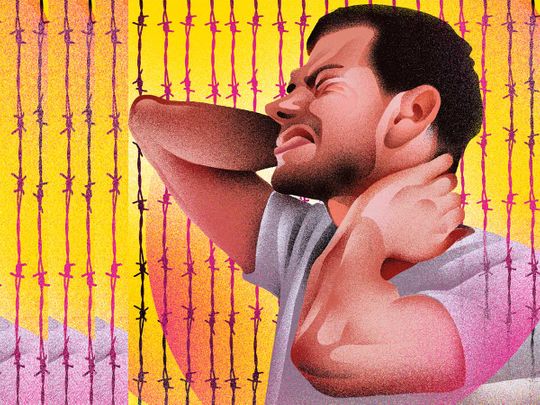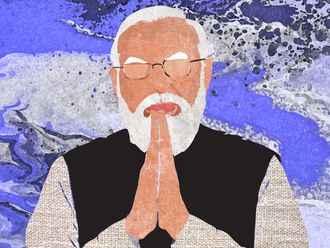
The United States uses a third of the world’s opioids but a fifth of Americans still say they suffer from chronic pain. The only demonstrable effect of two decades of widespread prescription of opioids has been catastrophic harm. With more than 47,000 Americans dying of opioid overdoses in 2017 and hundreds of thousands more addicted to them, it was recently reported that, for the first time, Americans were more likely to die of opioids than of car accidents.
This has forced many to take a step back and ponder the very nature of pain, to understand how best to alleviate it.
The ancient Greeks considered pain a passion — an emotion rather than a sensation like touch or smell. During the Dark Ages in Europe, pain was seen as a punishment for sins, a spiritual and emotional experience alleviated through prayers rather than prescriptions.
In the 19th century, the secularisation of western society led to the secularisation of pain. It was no longer a passion to be endured but a sensation to be quashed.
The concept of pain as a purely physical phenomenon reached its zenith in the 1990s, when medical organisations such as the American Pain Society and the Department of Veterans Affairs succeeded in having pain designated a “fifth vital sign,” alongside blood pressure, temperature and breathing and heart rate.
This coincided with the release of long-acting opioids like OxyContin. Doctors believed they now had an effective remedy for their patients’ suffering.
While opioids do help many patients with acute pain from injuries, surgeries or conditions like cancer, looking back it’s clear that using opioids to treat chronic pain — backaches, bum knees and the like — might well be considered the worst medical mistake of our era.
Decades of research suggests that opiates provide little to no benefit for chronic non-cancer pain. One recent randomised trial of people with chronic joint and back pain showed that patients using opioids experienced slightly more pain compared with those using medications like acetaminophen and ibuprofen.
Why is this? Studies have shown that opioids can reduce patients’ pain thresholds. They can also result in a condition called opioid-induced hyperalgesia, in which people feel more and more pain as they are prescribed higher and higher doses of opioids.
The conventional thinking about pain as purely a physical stimulus has clearly failed us. Maybe the ancient Greeks knew something we don’t.
The mind’s role
While the expression that suffering is “all in your head” is too often used to diminish others’ agony, the mind does play a pivotal role in the experience of pain. After a pain signal reaches the brain, it undergoes significant reprocessing.
How much something hurts can vary depending on factors like your expectations, your mood and how distracted you are. Just seeing someone else in pain can make you feel worse, too. This phenomenon has been demonstrated in studies of both rodents and humans. In other words, pain is contagious and transmittable.
There is also an incredibly strong association between pain and mental health. Conditions like depression and anxiety greatly increase the chance of developing chronic pain, while patients who experience pain are at high risk of developing depression or anxiety. This vicious cycle is partly a result of the fact that there is considerable overlap in the areas of the brain that deal with pain and emotion.
Additional clues about the fuzzy line between sensation and perception come from pain’s creepy bedfellow: itching.
The sensation of itchiness, which is perceived by some of the same skin receptors that are on the lookout for pain, may seem like a purely physical phenomenon, but it’s not. Just seeing someone else scratch, or thinking about feeling ticklish, can make you itchy, too. Like pain, it can be alleviated through distraction. And like pain, it is closely linked to mental health disorders such as depression and obsessive compulsive disorder.
All this is not to say that there is no physical component to these feelings. Objectively, there is no doubt that illnesses and injuries can cause immense suffering. The question is how severe that suffering is, and how long it lasts. Recent research shows that pain sensitivity varies significantly among people, most likely as a result of genetic differences. There is so much that we still don’t understand about the fundamental biology of pain, and that needs to change.
Increasing research funding
In the meantime, there is plenty we can do to address the pain epidemic. For too long the pharmaceutical industry has blurred our vision. It was just revealed in court filings that drug companies greatly underplayed the risks of opioids, while billions of dollars in marketing told people that pills were the only answer to their ailments.
There is a pressing need to increase funding for research into strategies that don’t just involve taking more drugs. Not every person who experiences acute pain goes on to develop chronic pain. We need to learn more about which interventions work to prevent this transformation.
Pain management should continue to be emphasised in medical education, but future doctors should be taught that pain is part of the story of the person who suffers from it, not just a separate physical phenomenon. And this education should incorporate ways to avoid prescribing opioids for chronic use.
Progress is already underway, as opioid prescription rates have been dropping since 2012 in the United States. But we still have a long way to go: The amount of opioids prescribed per person remains three times higher than it was 20 years ago.
Empathy
Perhaps the most important tool physicians need to manage pain is empathy.
If chronic pain is as much an emotion as a sensation, then it is unlikely to be managed successfully without compassion. A 2017 study of doctors in Spain found that those whose patients rated them as empathetic were more effective at relieving their patients’ pain. Physical therapy that doesn’t just manipulate joints but also addresses the context pain comes alive in, encourages optimism and builds emotional resilience has been found to be more effective.
All this takes more time and attention than just prescribing a pill, and unfortunately our health system encourages doctors to see as many patients as possible as quickly as possible. We need to change how physicians are paid in order to give them the time to really talk with patients about their pain.
Back in medical school, I dislocated a disc in my back. In a snap, pain became my constant companion: It was the last thing I felt before I slept, the first feeling I had when I woke up. Unable to leave my dorm, I fell into a dark hole. I looked fine on the outside but was moth-eaten on the inside. I was adamant that I would avoid painkillers, especially opioids. I had no idea about the science that would emerge over the next few years. I felt that the pain was my body’s way of telling me that something was wrong, and I didn’t want to silence that voice with a temporary fix. What pulled me out after almost a year of agony was not just rigorous physical therapy that moulded my spine back into shape but also the kindness of my friends, my family and my future wife.
When I see a patient with chronic pain, I try to see that person through the eyes of my younger self. When someone experiences chronic pain, there is no way to quantify it — no blood test to draw, no imaging test to order. It requires physicians to practise medicine the way it was long before the discovery of morphine. In essence, it represents the purest of medical encounters, and an opportunity, if not to cure, then to heal.
Haider Warraich, a fellow in advanced heart failure and transplantation at Duke University Medical Centre, is the author of the forthcoming “State of the Heart: Exploring the History, Science, and Future of Cardiac Disease.”











